
Chatham is one of the 77 community areas of the city of Chicago, Illinois. It is located on the city's South Side. It includes the neighborhoods of Chatham-Avalon, Chatham Club, Chesterfield, East Chatham, West Chatham and the northern portion of West Chesterfield. Its residents are predominantly African American, and it is home to former Senator Roland Burris. Housing many city employees and other officials, Chatham has been a central area for Chicago's middle-class African Americans since the late 1950s.
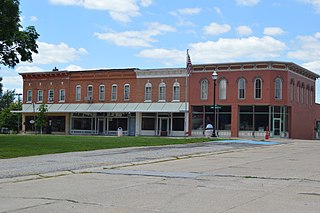
Barry Historic District is a historic district comprising the commercial and older residential areas of Barry, Pike County, Illinois. Barry was founded as an agricultural community in the 1830s, and most of its development took place between its founding and the Civil War. The city's commercial core, however, was mainly built in 1894 after a fire destroyed most of the existing commercial buildings. The 1894 buildings are well-preserved examples of typical commercial architecture of the period, and several have metal storefronts. The district also includes Barry's "Diamond Hill" residential district on Mortimer Street east of Brown Street and several other residential sections. Prominent architectural styles in the residential areas include Italianate, Queen Anne, Carpenter Gothic, and vernacular types from the late 19th century.

The Belleville Historic District is a historic district in Belleville, Illinois. The primarily residential district consists of an irregularly shaped area on the east side of Belleville. 70 buildings are included in the district, all of which are contributing buildings to its historic character. The homes in the district represent Belleville's residential development from 1830 to 1900. Many of the houses were designed in a vernacular cottage style popular among the city's German immigrants; while common in Belleville and other Metro-East cities, the style is little seen elsewhere in the state. Formal architectural styles such as Greek Revival and Italianate are also prevalent in the district.

The Lebanon Historic District is a historic district composed of the areas of Lebanon, Illinois, developed prior to 1900. The district includes five distinct areas of Lebanon: the city's main commercial district, the neighborhood around McKendree University, two residential districts, and an archaeological site at the city limits. Development in Lebanon began in the 1820s, and McKendree University was founded in 1828. The oldest building from this period, the Mermaid House Hotel, is a Federal structure dating to 1830. The city received an influx of German immigrants from the 1830s onward, which affected the city's development. In the 1850s and 1860s, a railroad opened in the city and several local industries developed; however, the city retained the character of a small college town and never developed into an industrial or trade center.

St. Mark's Episcopal Church, also known as St. Mark's, Capitol Hill, is a historic Episcopal church located at 3rd and A Streets, Southeast in the Capitol Hill neighborhood of Washington, D.C.. Built 1888–1894, the church is an example of Gothic Revival and Romanesque Revival architectures.
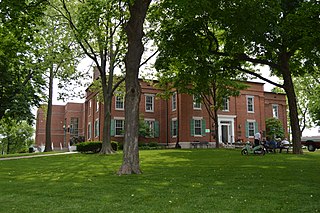
The Waterloo Historic District is a historic district composed of the majority of central Waterloo, Illinois. The district includes 271 buildings, of which 182 are contributing buildings to its historic character. The center of the district includes Waterloo's town square, the site of the Monroe County Courthouse, as well as a two-block section of Main Street which forms the city's commercial core. The town square is surrounded by residential development on three sides, an unusual arrangement among small towns in Illinois. The predominant architectural styles in the residential parts of the district are local adaptations of the Federal style and a German cottage style developed by the city's German immigrants in the 19th century.
Hurt Park is a Roanoke, Virginia neighborhood located in central Roanoke between the Norfolk Southern railyard and the Roanoke River. It borders the neighborhoods of Cherry Hill on the west, West End on the east, Gilmer, Loudon-Melrose and Shenandoah West on the north across the Norfolk Southern railyard and Norwich across the Roanoke River and Mountain View on the south.
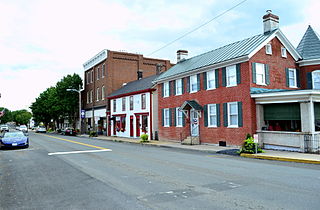
Strasburg Historic District is a national historic district located at Strasburg, Shenandoah County, Virginia. The district encompasses 206 contributing buildings and 1 contributing site in the town of Strasburg. It includes a variety of commercial, residential, and institutional buildings dating from the 18th to 20th centuries. Notable buildings include the George Eberly House, Presbyterian Church, Alton House, Spengler Hall, Spengler's Mill (1794), Bell Pottery (pre-1878), Strasburg Christian Church, Strasburg Methodist Church (1905), St. Paul's Lutheran Church (1892), First National Bank, Home Theatre (1930s), Strasburg School (1910) and the Sonner House (1757).

There are 69 properties listed on the National Register of Historic Places in Albany, New York, United States. Six are additionally designated as National Historic Landmarks (NHLs), the most of any city in the state after New York City. Another 14 are historic districts, for which 20 of the listings are also contributing properties. Two properties, both buildings, that had been listed in the past but have since been demolished have been delisted; one building that is also no longer extant remains listed.

The Riverview Terrace Historic District is a 15.2-acre (6.2 ha) historic district in Davenport, Iowa, United States, that was listed on the National Register of Historic Places in 1984. It was listed on the Davenport Register of Historic Properties in 1993. The neighborhood was originally named Burrow's Bluff and Lookout Park and contains a three-acre park on a large hill.

Four Corners is the intersection of Broad and Market Streets in Newark, New Jersey. It is the site of the city's earliest settlement and the heart of Downtown Newark that at one time was considered the busiest intersection in the United States. The area that radiates 22 square blocks from the crossroads is a state and federal historic district.

Woodsdale–Edgewood Neighborhood Historic District is a national historic district located at Wheeling, Ohio County, West Virginia. The district encompasses 969 contributing buildings and is primarily residential, developed between 1888 and 1945. A number of popular architectural styles are represented including Shingle Style, Queen Anne, Tudor Revival, American Foursquare, Colonial Revival and Bungalow style. The district also includes four Lustron houses. Notable non-residential buildings include the Edgwood Christian Mission Alliance Church (1932), St. John's Episcopal Chapel (1913), Mount Carmel Monastery (1915) designed by Frederick F. Faris (1870-1927), and Good Shepherd Home (1912). Also located in the district are the separately listed H. C. Ogden House and William Miles Tiernan House.

The Holy Family Catholic Church Historic District, in Natchez, Mississippi, is a 9.2-acre (3.7 ha) historic district that was listed on the U.S. National Register of Historic Places (NRHP) in 1995. The district is small, relative to other historic districts in Natchez such as the Natchez On-Top-of-the-Hill Historic District which is adjacent, on the west. Its most significant building is the Holy Family Church, the first African-American Catholic church in the state; dedicated in 1894, it is Natchez's best piece of Gothic Revival architecture. Most other buildings in the district are cottages in Queen Anne, Eastlake, Colonial Revival, bungalow, and American Craftsman architectural styles. The district as a whole is significant for its architecture and for its African-American historical associations.
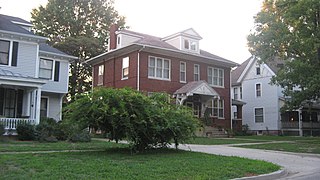
The Elliott Street Historic District is a historic district comprising five blocks of South Elliott Street in Olney, Illinois. The district is primarily residential; all but four of the 33 main buildings in the district are single-family homes. South Elliott Street has historically been one of the most desirable neighborhoods in Olney, and the area has consequently been known as the "Silk Stocking District" since the 1850s. The section of Olney including South Elliott Street was platted by William Elliott in 1855, shortly after the Ohio and Mississippi Railroad came through the city and sparked population growth and commercial development. Several of Olney's pioneers lived in the district, including Aaron Shaw, a U.S. Representative who gave the city its name. The houses in the district represent a variety of popular architectural styles of the late 19th and early 20th centuries, including Italianate, Queen Anne, and Georgian Revival.

The Red Bud Historic District is a commercial and residential historic district which includes the originally developed portions of Red Bud, Illinois, United States. The district is centered on Main and Market Streets, the primary roads through the city. One hundred and ninety-five buildings and structures, including 138 contributing buildings, are included in the district. The oldest building in the district, the Greek Revival Durfee and Crozier Store, dates from 1855, seven years after Red Bud was platted. The community rapidly developed between the 1850s and 1880s, and architectural styles from these decades are prominently represented in the district. The Federal and Italianate styles are the two most prevalent in the district, the latter being an especially popular commercial design. Gothic Revival churches, Second Empire buildings, and a number of German-style cottages can also be found in the district. Development and population growth in Red Bud remained stable in Red Bud from the 1890s through most of the 20th century, and the historically developed core makes up most of the modern city.

The Alton Military Prison was a prison located in Alton, Illinois and originally built in 1833 as the first state penitentiary in Illinois and later closed in 1857. During the American Civil War, the prison was reopened in 1862 to accommodate the growing population of Confederate prisoners of war and ceased to be prison at the end of the war in 1865. The prison building was demolished not long after the Civil War. All that remains of the former prison site is a section of ruin wall that is maintained by the State of Illinois as an historic site. The prison site is included in the U.S. National Register of Historic Places.

The Middletown Historic District is a historic district in Alton, Illinois. The primarily residential district includes portions of Alton's Middletown and Hunterstown neighborhoods and comprises 653 buildings, 613 of which are contributing buildings. Settlement in the district dates to the original plat of Alton in 1817, which included the southern half of Middletown. Development in the district continued through the 19th century and into the 20th, spanning all of Alton's early history. The district also represents multiple eras of Alton's architectural history. Most early houses in the district were designed in the Federal style, while the Italianate and Queen Anne styles were predominant in the latter half of the 19th century.

The Upper Alton Historic District is a historic district located in northeast Alton, Illinois, in what was once the separate town of Upper Alton. The district includes the campuses of Shurtleff College and the Western Military Academy as well as the surrounding residential areas. Upper Alton was platted in 1817, but it did not grow significantly until the 1830s, when Shurtleff College opened; the college dominated the town for decades, and most of the houses around it were built for the school or its professors. The college's buildings were mainly designed in the Classical Revival and Greek Revival style, while the houses were designed in the Classical Revival and Queen Anne styles. In 1879, the Western Military Academy opened in the John Bostwick House; while the house burned in 1903, the Academy rebuilt immediately and continued operations. The Academy's campus is mainly designed in the Tudor Revival style. Shurtleff College closed in 1957 and is now the Southern Illinois University School of Dental Medicine; the Western Military Academy also closed in 1971.
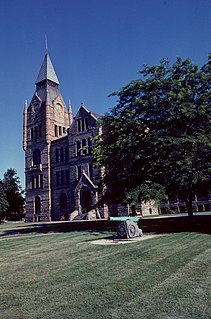
The Galesburg Historic District is a 496-acre (201 ha) historic district in Galesburg, Illinois. The district includes 1049 contributing buildings and contains the town's original plat as well as several older neighborhoods. The section of the district south of North Street encompasses Galesburg's historic city center and its most significant landmarks, such as the Knox County Courthouse, the Knox County Jail, the Burlington Depot, and Main Street's commercial buildings. Knox College, the school Galesburg was founded to serve, and its historic Old Main are also located in the southern half of the district. The area north of North Street is mainly residential and is dominated by Queen Anne and Classical Revival houses, including many transitional houses displaying elements of both styles.

Park Mary Historic District is a national historic district located at Lafayette, Tippecanoe County, Indiana. The district encompasses 106 contributing buildings and 1 contributing structure in a predominantly residential section of Lafayette. It developed between about 1853 and 1950 and includes representative examples of Italianate, Queen Anne, and Bungalow / American Craftsman style architecture. Notable contributing buildings include the Thomas Hull House (1870), Fry House (1873), Perrin House (1868), Fletmeyer House (1881), Keipner House (1885), Behm House (1858), Greagor House (1873), Ulrick House, John and William Levering House (1858), Sawyer House (1868), Lafayette Christian Reformed Church (1929), Lincoln School (1923), and Lafayette Armory (1927).





















